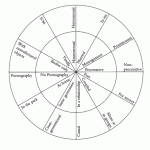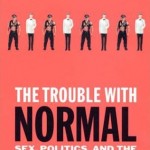Note: Having just finished this entry after almost 4 days of deliberating over how to frame it and what to write, I feel compelled to comment on my blogging process. I am not sure if this entry makes sense, but it has been incredibly productive for me as I attempt to place my own thinking about virtue ethics and troublemaking in a larger context. Writing this entry has enabled me to clarify my thinking, generated a lot of new questions and sources, and has fueled my passion for troubling virtue ethics. Cool. This entry is one reason why I love blog writing.
Way back at the end of May, I wrote a rather lengthy entry about Peter Sagal’s book, The Book of Vices. I had a big problem with a key passage in his introduction:
In the long war between Vice and Virtue, Virtue has been met on the battlefield, routed, defeated in detail, occupied, and reeducated in prison camps. When last seen, Virtue was working on the Strip in Las Vegas, handing out color flyers advertising in-room exotic dancers. She says she’s happy, but she doesn’t meet your eyes (2).
I don’t want to rehash my argument in this entry. Instead, I want to take up the question of what happens to virtue when we trouble it (queer it? displace it? pose problems to it? jam its codes? rework it)? Does the troubling of virtue necessarily lead to the valuing of vice? What is/should be the relationship between virtue and vice? And what kind of virtue (or vice?) is troublemaking?
But first, back to Sagal. In Sagal’s passage, virtue has been overtaken (corrupted?) by vice. The moral system has been reversed, with vice replacing virtue as the guiding force for many Americans’ excessive and immoral behaviors. Sagal’s reversal of moral codes is not meant so much as a valuing of vice (or especially those practices, identities, or communities that are understood to be vices), but a mocking of virtue and those individuals who promote it but fail to practice it.
 There are many reasons why I find this approach problematic. One key reason: it uses practices that are deemed vices, and the individuals/communities who practice them, as the raw material and the evidence for mocking conservative values. And who, quite frequently, are these folks (that is, the raw material)? Radical sex workers or individuals or communities who engage in non-heteronormative (queer?) sex practices. That’s right, all of those people whose sexual practices fall outside of the inner charmed circle that Gayle Rubin discusses in “Thinking Sex“. Because of their improper (deviant) practices these folks are understood as having fully rejected virtues and any “proper” moral codes. In Sagal’s version of virtue and vice, with vice vanquishing virtue, those who are relegated to the vice category seem not only to be in opposition to ethics, but serve as the proof that ethics/virtues have failed or no longer exist.
There are many reasons why I find this approach problematic. One key reason: it uses practices that are deemed vices, and the individuals/communities who practice them, as the raw material and the evidence for mocking conservative values. And who, quite frequently, are these folks (that is, the raw material)? Radical sex workers or individuals or communities who engage in non-heteronormative (queer?) sex practices. That’s right, all of those people whose sexual practices fall outside of the inner charmed circle that Gayle Rubin discusses in “Thinking Sex“. Because of their improper (deviant) practices these folks are understood as having fully rejected virtues and any “proper” moral codes. In Sagal’s version of virtue and vice, with vice vanquishing virtue, those who are relegated to the vice category seem not only to be in opposition to ethics, but serve as the proof that ethics/virtues have failed or no longer exist.
But what would happen if we thought about those practices that have been labeled vices as having some ethical content? Could it be possible to claim them as virtues and as part of the foundation for a new sort of ethics? Or, could it be possible to resignify (or maybe disidentify) with the category of vice–to inhabit it, but use it differently by reclaiming it or reimagining it as ethically valuable? Is this what Michael Warner is attempting to do in The Trouble with Normal with his ethics of shame?
Okay, in asking this question about Warner I realized that I needed to go back and revisit what he actually says about an ethics of shame, so I re-skimmed the first chapter of The Trouble with Normal. Very useful.
One way to think about vice as ethically valuable is to open up the category of virtue to a much wider range of possibilities for what counts as virtuous practices (So, those practices formerly deemed vices would be re-imagined as virtues–practices like fist-fucking.) Some might ask: Does this lead to unbridled relativism and moral chaos, where any and all practices (as long as some folks like doing them!) are morally acceptable? Gayle Rubin, in “Thinking Sex: Notes for a Radical Theory and the Politics of Sexuality” understands this question to come out of a belief in the “domino theory of sexual peril” and the “fear that if anything is permitted to cross this erotic DMZ [the line between proper and improper sexual practices], the barrier against scary sex will crumble and something unspeakable will skitter across” (Rubin, 14). This fear of relativism and the loss of morals, leads many to conclude that lines must be drawn (and strictly adhered to) between what is proper behavior (virtue) and what is improper behavior (vice).
But Michael Warner, in his ethics of shame, sees the expanding of morality (virtue) differently. Framing his discussion of it in terms of sexual autonomy and dignity, he writes:
Sexual autonomy has grown…by making room for new freedoms, new experiences, new pleasures, new identities, new bodies–even if many of us turn out to live in the old ones without complaining.…Pleasures once imaginable only with disgust, if at all, become the material out of which individuals and groups elaborate themselves (12).
 For Warner, sexual autonomy is about dignity and one’s humanity (Judith Butler’s ideas about the livable life and the human are echoing in my head right now) and is central to an ethical project based on morality and not moralism (where sexual practices and tastes are mandated for everyone). This ethical project uses practices/communities that engage in “shameful” acts as the raw material (not a la Sagal, for jokes proving how corrupt we are all) for an ethics of dignity, autonomy and (human) community.
For Warner, sexual autonomy is about dignity and one’s humanity (Judith Butler’s ideas about the livable life and the human are echoing in my head right now) and is central to an ethical project based on morality and not moralism (where sexual practices and tastes are mandated for everyone). This ethical project uses practices/communities that engage in “shameful” acts as the raw material (not a la Sagal, for jokes proving how corrupt we are all) for an ethics of dignity, autonomy and (human) community.
So, Warner envisions an ethics that is grounded in shame, disgust, repulsion, embarrassment. Aren’t those the emotions we are supposed to feel when we recognize that our practices are vices instead of virtues? Interesting…
But, wait, it gets better. Consider what Warner writes about dignity, indignity and shame. Distancing his understanding of dignity from the “bourgeois propriety” version of it in which dignity is assigned to only some sex practices (heterosexual, private, loving), “as long as they are out of sight” (37), Warner imagines rethinking (resignifying/disdentifying with) dignity through indignity. He describes this as a queer ethic of dignity in shame:
If sex is a kind of indignity, then we’re all in it together. And the paradoxical result is that only when this indignity of sex is spread around the room, leaving no one out, and in fact binding people together, that it begins to resemble the dignity of the human (36).
 Wow! How come I didn’t see this passage before? Pondering this significance of Warner’s claim, I am reminded of Butler’s idea of being undone by others. What connections and/or disconnections do we see between envisioning indignity (shame, disgust, could we include failure here?) as the foundation for our humanity (Warner) and understanding our subjectivity (and humanity) to be predicated on our vulnerability and undone-ness (Butler)? I need to think about this some more–I want to read Warner’s claim as being more than a call for those who are labeled undignified or disgusting to develop coalitions (even though this is important); I want to think about it as a call for a new version of humanity and a new vision of ethics–one that resignifies and claims vice (disgust, shame, failure) as virtue.
Wow! How come I didn’t see this passage before? Pondering this significance of Warner’s claim, I am reminded of Butler’s idea of being undone by others. What connections and/or disconnections do we see between envisioning indignity (shame, disgust, could we include failure here?) as the foundation for our humanity (Warner) and understanding our subjectivity (and humanity) to be predicated on our vulnerability and undone-ness (Butler)? I need to think about this some more–I want to read Warner’s claim as being more than a call for those who are labeled undignified or disgusting to develop coalitions (even though this is important); I want to think about it as a call for a new version of humanity and a new vision of ethics–one that resignifies and claims vice (disgust, shame, failure) as virtue.
This resignifying of vice is not a mere reversal of the virtue/vice binary so that what we think to be bad is actually good, and what we think is good is actually bad. And, it is not just an expansion of the list of virtues to include those things that have been previously understood to have no ethical content (only in opposition to ethics). So, what is it?
To be continued…

Comments are closed.